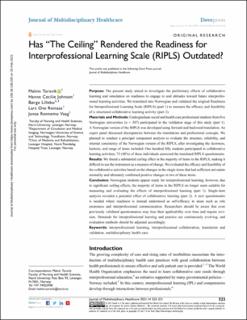| dc.contributor.author | Torsvik, Malvin Arnold | |
| dc.contributor.author | Johnsen, Hanne Cecilie | |
| dc.contributor.author | Lillebo, Børge | |
| dc.contributor.author | Reinaas, Lars Ove | |
| dc.contributor.author | Vaag, Jonas Rennemo | |
| dc.date.accessioned | 2021-09-21T07:58:41Z | |
| dc.date.available | 2021-09-21T07:58:41Z | |
| dc.date.created | 2021-02-21T21:38:47Z | |
| dc.date.issued | 2021 | |
| dc.identifier.citation | Journal of Multidisciplinary Healthcare. 2021, 14, 523—531. | en_US |
| dc.identifier.issn | 1178-2390 | |
| dc.identifier.uri | https://hdl.handle.net/11250/2779752 | |
| dc.description.abstract | Purpose: The present study aimed to investigate the preliminary effects of collaborative learning and simulation on readiness to engage in and attitudes toward future interprofessional learning activities. We translated into Norwegian and validated the original Readiness for Interprofessional Learning Scale (RIPLS) (part 1) to measure the efficacy and feasibility of a structured collaborative learning activity (part 2).
Materials and Methods: Undergraduate social and health care professional students from five Norwegian universities (n = 307) participated in the validation stage of this study (part 1). A Norwegian version of the RIPLS was developed using forward and backward translation. An expert panel discussed discrepancies between the translations and professional concepts. We planned to conduct a principal component analysis to evaluate the structure, reliability, and internal consistency of the Norwegian version of the RIPLS, after investigating the skewness, kurtosis, and range of items included. One hundred fifty students participated in collaborative learning activities; 72 (48%) of these individuals answered the translated RIPLS questionnaire.
Results: We found a substantial ceiling effect in the majority of items in the RIPLS, making it difficult to use the instrument as a measure of change. We evaluated the efficacy and feasibility of the collaborative activities based on the changes in the single items that had sufficient univariate normality and ultimately confirmed positive changes in two of these items.
Conclusion: Norwegian students appear ready for interprofessional learning; however, due to significant ceiling effects, the majority of items in the RIPLS no longer seem suitable for measuring and evaluating the effects of interprofessional learning (part 1). Single-item analysis revealed a potential effect of collaborative learning (part 2). A new questionnaire is needed where readiness is instead understood as self-efficacy in areas such as role awareness and interprofessional communication. Researchers should be aware that even previously validated questionnaires may lose their applicability over time and require revision. Demands for interprofessional learning and practice are continuously evolving, and evaluation methods should be adjusted accordingly. | en_US |
| dc.language.iso | eng | en_US |
| dc.publisher | Dove Press | en_US |
| dc.rights | Navngivelse-Ikkekommersiell 4.0 Internasjonal | * |
| dc.rights.uri | http://creativecommons.org/licenses/by-nc/4.0/deed.no | * |
| dc.title | Has “The Ceiling” Rendered the Readiness for Interprofessional Learning Scale (RIPLS) Outdated? | en_US |
| dc.type | Peer reviewed | en_US |
| dc.type | Journal article | en_US |
| dc.description.version | publishedVersion | en_US |
| dc.source.pagenumber | 523—531 | en_US |
| dc.source.volume | 14 | en_US |
| dc.source.journal | Journal of Multidisciplinary Healthcare | en_US |
| dc.identifier.doi | 10.2147/JMDH.S296418 | |
| dc.identifier.cristin | 1892143 | |
| cristin.ispublished | true | |
| cristin.fulltext | original | |
| cristin.qualitycode | 1 | |

